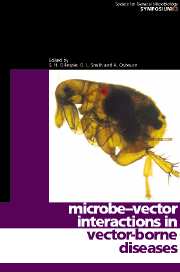Book contents
- Frontmatter
- Contents
- Contributors
- Editors' Preface
- 1 Vector-borne diseases
- 2 Evolution of tick-borne disease systems
- 3 Insect transmission of viruses
- 4 RNA-based immunity in insects
- 5 Specificity of Borrelia–tick vector relationships
- 6 Bunyavirus/mosquito interactions
- 7 How do mosquito vectors live with their viruses?
- 9 Vector competence
- 9 Environmental influences on arbovirus infections and vectors
- 10 Vector immunity
- 11 Transmission of plant viruses by nematodes
- 12 Wolbachia host–symbiont interactions
- 13 Pathogenic strategies of Anaplasma phagocytophilum, a unique bacterium that colonizes neutrophils
- 14 Interactions of Yersinia pestis with its flea vector that lead to the transmission of plague
- 15 Transgenic malaria
- 16 Vaccines targeting vectors
- Index
10 - Vector immunity
Published online by Cambridge University Press: 06 July 2010
- Frontmatter
- Contents
- Contributors
- Editors' Preface
- 1 Vector-borne diseases
- 2 Evolution of tick-borne disease systems
- 3 Insect transmission of viruses
- 4 RNA-based immunity in insects
- 5 Specificity of Borrelia–tick vector relationships
- 6 Bunyavirus/mosquito interactions
- 7 How do mosquito vectors live with their viruses?
- 9 Vector competence
- 9 Environmental influences on arbovirus infections and vectors
- 10 Vector immunity
- 11 Transmission of plant viruses by nematodes
- 12 Wolbachia host–symbiont interactions
- 13 Pathogenic strategies of Anaplasma phagocytophilum, a unique bacterium that colonizes neutrophils
- 14 Interactions of Yersinia pestis with its flea vector that lead to the transmission of plague
- 15 Transgenic malaria
- 16 Vaccines targeting vectors
- Index
Summary
INTRODUCTION
Invertebrates, particularly insects, act as vectors of the most debilitating diseases in many already socially and economically compromised populations of the developing world. The diseases vectored include malaria, sleeping sickness, Chagas’ disease, leishmaniasis, lymphatic filariases and river blindness, dengue and yellow fever, and schistosomiasis. Only the latter is transmitted by non-insectan invertebrates, i.e. snails of the genus Biomphalaria. Hurd (2003) recently pointed out that of the ten most important tropical diseases affecting the poorer nations, eight of these are transmitted by invertebrate vectors (Table 1). In addition, and often underestimated in importance since they are probably second only to mosquitoes as vectors of human infectious diseases (Parola & Raoult, 2001), are the ticks. In fact, in the USA ticks transmit more vector-borne diseases than any other vector (US Centers for Disease Control and Prevention, 1999). The diseases transmitted by ticks include Lyme borreliosis, tick-borne encephalitis, ehrlichiosis and babesiosis (Gratz, 1999).
The reason that insects are particularly widespread vectors undoubtedly reflects the success of this group, occupying almost every habitat on earth in vast numbers. In addition, their power of flight, their extraordinarily well developed sense organs and their haematophagous habit have made them ideal vehicles for transmitting human blood-borne diseases. Since many insects live in places infested with pathogens and parasites they can only do so due to the extreme efficiency of their immune defences so that any invading parasite must counteract these defences to survive.
Thus, most parasites are not simply passively transported from human to human by their vectors, but interact intimately with their invertebrate hosts, usually undergoing significant biochemical and molecular modifications to survive, differentiate and multiply in their vectors.
- Type
- Chapter
- Information
- Microbe-vector Interactions in Vector-borne Diseases , pp. 199 - 262Publisher: Cambridge University PressPrint publication year: 2004
- 6
- Cited by



